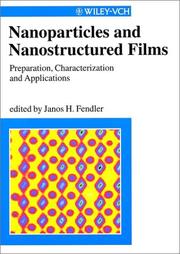| Listing 1 - 10 of 91 | << page >> |
Sort by
|
Dissertation
Abstract | Keywords | Export | Availability | Bookmark
 Loading...
Loading...Choose an application
- Reference Manager
- EndNote
- RefWorks (Direct export to RefWorks)

ISBN: 0897669282 0897669274 9780897669276 9780897669283 Year: 1995 Volume: 750 Publisher: New York (N.Y.) : New York academy of sciences,
Abstract | Keywords | Export | Availability | Bookmark
 Loading...
Loading...Choose an application
- Reference Manager
- EndNote
- RefWorks (Direct export to RefWorks)
Enzymes --- Biotechnology --- Biomedical engineering --- Antibodies --- Catalysis --- Lipases --- Micelles --- Reaction mechanism
Book
ISBN: 3038428086 Year: 2018 Publisher: Basel : MDPI - Multidisciplinary Digital Publishing Institute,
Abstract | Keywords | Export | Availability | Bookmark
 Loading...
Loading...Choose an application
- Reference Manager
- EndNote
- RefWorks (Direct export to RefWorks)
Classically, polymer micelles have been defined as aggregates formed by the self-association of amphiphilic polymers due to the hydrophobic interactions between polymer molecules in water. Practical applications of polymer micelles include as carriers in drug delivery systems, as solubilizers, and as associative thickeners. Polymer micelles that do not fall within the classical definition have recently been reported and reflect important developments in synthesis and analysis. For example, hydrophobic interactions are the classic force driving polymer association, whereas recently, micelles have been formed through interactions such as electrostatics, hydrogen bonds, and coordination bonds. Intermolecular association results in the formation of polymer micelles that are similar to micelles formed from low molecular weight surfactants, whereas unimolecular micelles formed by intramolecular association within a single polymer chain have also been reported, as have stimuli-responsive polymer micelles. It is therefore important to constantly update the information available and our knowledge of polymer micelles. This special issue covers synthesis, characterization, solution properties, association behavior, simulation, and the application of polymer micelles and polymer aggregates. The aim of this issue is to expand our knowledge of polymer micelles by gathering together the latest basic and applied information regarding these supramolecular structures.
Polymers. --- Micelles. --- Colloids --- Polymere --- Polymeride --- Polymers and polymerization --- Macromolecules
Book
ISBN: 1560815868 Year: 1992 Publisher: New York, NY : VCH Publishers,
Abstract | Keywords | Export | Availability | Bookmark
 Loading...
Loading...Choose an application
- Reference Manager
- EndNote
- RefWorks (Direct export to RefWorks)
Surface active agents. --- Surface chemistry. --- Emulsions --- Foams --- Liquid crystals --- Membranes --- Micelles --- Surface (chemistry and physics) --- Surfactants

ISBN: 0471561398 0471305960 Year: 1995 Publisher: New York (N.Y.) Wiley-Liss
Abstract | Keywords | Export | Availability | Bookmark
 Loading...
Loading...Choose an application
- Reference Manager
- EndNote
- RefWorks (Direct export to RefWorks)
Provides a fundamental understanding of the biophysical chemical properties of membrane structure and membranes' role and function in biological systems. Covers the characteristics of molecules, monolayers, more complex micelles and liposomes. Describes the significance of membrane structure, how receptors and other cell surface molecules are anchored within it, signal transduction plus the motion of proteins within and through it. Emphasizes the physical properties of biological processes.
Hydrophobic surfaces. --- Membranes (Biology) --- Micelles --- Monomolecular films --- Hydrophobic surfaces --- Micelles. --- Biological membranes --- Biomembranes --- Biological interfaces --- Protoplasm --- Molecular films --- Monolayers --- Unilayers --- Thin films --- Colloids --- Lipophilic surfaces --- Surfaces, Hydrophobic --- Surfaces, Lipophilic --- Surface chemistry --- Emulsions --- Membranes (Biology). --- Monomolecular films. --- Micelle

ISBN: 3527294430 Year: 1998 Publisher: Weinheim Wiley-VCH
Abstract | Keywords | Export | Availability | Bookmark
 Loading...
Loading...Choose an application
- Reference Manager
- EndNote
- RefWorks (Direct export to RefWorks)
539.24 --- Microstructure revealed by photomicrography. Structure of very small particles --- Nanoparticles --- Nanostructure materials --- nanoclusters --- Handbooks, manuals, etc. --- Zeolites --- Zeta potential --- heterosupramolecular chemistry --- silicon --- monoelectron conductivity --- aggregates --- semiconductor nanoparticles --- thin films --- colloid reaction kinetics --- fullerenes --- template synthesis --- nanoporous membranes --- metal colloids --- block copolymer micelles --- block copolymer micelles. --- 539.24 Microstructure revealed by photomicrography. Structure of very small particles --- Nanoclusters --- Heterosupramolecular chemistry --- Silicon --- Monoelectron conductivity --- Aggregates --- Semiconductor nanoparticles --- Thin films --- Colloid reaction kinetics --- Fullerenes --- Template synthesis --- Nanoporous membranes --- Metal colloids --- Block copolymer micelles.
Book
ISBN: 9535125109 9535166689 9535125095 Year: 2016 Publisher: IntechOpen
Abstract | Keywords | Export | Availability | Bookmark
 Loading...
Loading...Choose an application
- Reference Manager
- EndNote
- RefWorks (Direct export to RefWorks)
This book is an Up-to-date and authoritative account on physicochemical principles, pharmaceutical and biomedical applications of hydrogels. It consists of eight contributions from different authors highlighting properties and synthesis of hydrogels, their characterization by various instrumental methods of analysis, comprehensive review on stimuli-responsive hydrogels and their diverse applications, and a special section on self-healing hydrogels. Thus, this book will equip academia and industry with adequate basic and applied principles related to hydrogels.
Colloids. --- Dispersoids --- Gels --- Hydrogels --- Sols --- Amorphous substances --- Chemistry, Physical and theoretical --- Diffusion --- Matter --- Micelles --- Particles --- Rheology --- Solution (Chemistry) --- Surface chemistry --- Properties --- Polymer chemistry

ISBN: 1281048275 0080534295 0444501789 9780444501783 9780080534299 Year: 2000 Publisher: Amsterdam New York Elsevier
Abstract | Keywords | Export | Availability | Bookmark
 Loading...
Loading...Choose an application
- Reference Manager
- EndNote
- RefWorks (Direct export to RefWorks)
Hydrocolloids
Hydrocolloids --- Colloids. --- Dispersoids --- Gels --- Hydrogels --- Sols --- Amorphous substances --- Chemistry, Physical and theoretical --- Diffusion --- Matter --- Micelles --- Particles --- Rheology --- Solution (Chemistry) --- Surface chemistry --- Colloids --- Gums and resins --- Properties
Book
ISBN: 0128052651 0081008651 9780128052655 9780081008652 Year: 2019 Publisher: London, United Kingdom : Academic Press, an imprint of Elsevier,
Abstract | Keywords | Export | Availability | Bookmark
 Loading...
Loading...Choose an application
- Reference Manager
- EndNote
- RefWorks (Direct export to RefWorks)
Colloids. --- Electrophoresis. --- Cataphoresis --- Electrochemistry --- Phase partition --- Dispersoids --- Gels --- Hydrogels --- Sols --- Amorphous substances --- Chemistry, Physical and theoretical --- Diffusion --- Matter --- Micelles --- Particles --- Rheology --- Solution (Chemistry) --- Surface chemistry --- Properties
Book
ISBN: 0081028288 0081028296 9780081028292 9780081028285 Year: 2020 Publisher: Amsterdam, Netherlands ; Kidlington, Oxford, England ; Cambridge, Massachusetts : Elsevier,
Abstract | Keywords | Export | Availability | Bookmark
 Loading...
Loading...Choose an application
- Reference Manager
- EndNote
- RefWorks (Direct export to RefWorks)
Colloids. --- Nanobiotechnology. --- Dispersoids --- Gels --- Hydrogels --- Sols --- Amorphous substances --- Chemistry, Physical and theoretical --- Diffusion --- Matter --- Micelles --- Particles --- Rheology --- Solution (Chemistry) --- Surface chemistry --- Properties
| Listing 1 - 10 of 91 | << page >> |
Sort by
|

 Search
Search Feedback
Feedback About UniCat
About UniCat  Help
Help News
News